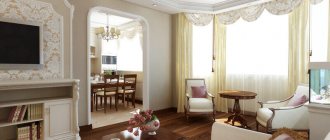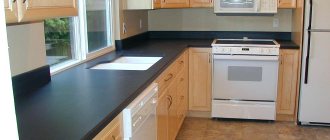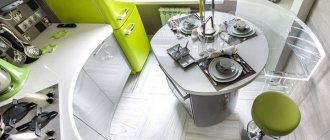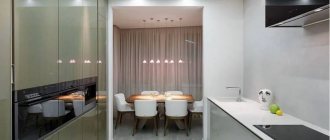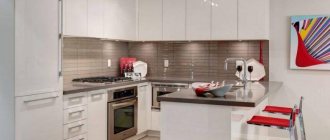Planning residential premises is a very responsible task, especially when it comes to developing a kitchen plan with dimensions and furniture. This is more than just creating a diagram that will indicate where to put the kitchen unit or seating area.
No, it is the preliminary work on paper that determines how functional, stylish and comfortable the room will be, which is, in fact, the heart of the house or apartment.
If you don’t know what to put and where, how to place a set with everything you need in a small kitchen, we advise you to carefully study this article and then apply the knowledge gained from it in practice. So let's get started.
Kitchen plan with dimensions and furniture
Types of layout
What is a corner kitchen? This is a kitchen in which all the furniture is located along two walls. The facades of the set are located perpendicularly. Among the layout options are:
- L-shaped kitchen: furniture is located along two walls. This modification is ideal for small rooms.
- L-shaped with a peninsula. One side of the corner is located along the wall, the shorter side is located across it, but is not adjacent to the wall, but has free access from both sides.
A desk or bar counter is most often designed as a peninsula. This layout is recommended for owners of a spacious square kitchen.Firstly, you get an ergonomic work area with a convenient triangular arrangement of the main items, and secondly, the peninsula helps to zone the room, highlighting the dining area.
- L-shaped plus island. In this case, a kitchen island is additionally equipped, which often replaces the work area. Another option is to install a table and chairs as an island to form a dining area.
- F-shaped.
The furniture is located along one wall. The first corner is formed at the junction of two walls. The second corner is most often shaped like a peninsula. This layout is excellent for elongated rooms, as it allows you to make maximum use of the usable area and helps to zone the kitchen, separating the work area from the dining room.
Advantages:
- 1 Compact. The corner location allows you to fit pieces of furniture even into a room with a non-standard layout. True, in this case it is better to choose custom-made furniture.
- 2 Capacity. The layout allows you to use corners that usually remain a “dead” zone. Corner cabinets with rotating sections provide additional and very spacious storage space.
- 3 Ergonomics. How to arrange kitchen furniture so that all important items are always at hand? There is a “golden rule of the triangle”: the refrigerator, sink and stove should be located at the tops of an imaginary triangle. This position is considered the most optimal and convenient.
- 4 Convenient zoning. With a corner layout, the work and dining areas are in opposite corners. This arrangement allows you to design the interior, emphasizing the zoning.
Possible disadvantages:
- 1 Sometimes modeling a corner furniture set can be very complicated if the room is non-standard and there are protrusions on the walls. This significantly increases the cost of both the furniture and the project as a whole.
- 2 In small kitchens, a sink is often placed in the corner. This may be an inconvenient option for large people, since there is little free space in front of the sink.
- 3 The shape of the room is of great importance. For example, for a narrow and elongated kitchen, corner furniture is an unwise choice. In this case, it is better to give preference to a linear arrangement of cabinets along one wall.
How to assemble a kitchen set
After the renovation is completed and you buy the kitchen set, you will need to assemble it. Unfortunately, representatives of the company from which you bought it will do this for an additional fee, therefore, it is better to learn how to assemble the headset yourself.
Step No. 1 – prepare the tools
In order to assemble a kitchen with your own hands, you will need to prepare the necessary tools:
- a screwdriver so as not to tighten the fasteners by hand;
- drill with a set of drills;
- jigsaw;
- hex keys;
- hammer;
- building level;
- pliers
- cutter;
- corners;
- centimeter tape measure.
Let's prepare the necessary tools
Step No. 2 – cabinet assembly
So, first you need to install cross-shaped fittings for hinged doors on the side surfaces. It “fits” onto the self-tapping screws.
Also, rails are mounted on the sidewalls, which are needed for retractable segments. This needs to be done at the very beginning, because doing it later will be problematic.
Cross fittings
Then, wooden dowels must be installed in the blind holes. These segments help achieve the following effects:
- assemble furniture much more evenly;
- increase the overall strength of the structure.
We connect cabinet segments with wooden dowels
It is better to fasten the dowels using glue.
After the dowels evenly fasten several parts together, you will need to use a hex key to screw in the screw that will finally connect them. A plastic plug is placed over the screw, which comes with the headset.
Step No. 3 – screw the legs
If the structure has legs, they will need to be screwed to the intended joint with the cabinets, and, if they have a regulator, the appropriate height for placing the furniture will be determined.
Screw the legs and adjust their height
In the case when you bought an inexpensive set of furniture, the legs will not be adjustable.
Step No. 4 – fastening fittings for wall cabinets and assembling pull-out segments
Add adjustable canopies to wall hanging cabinets. These canopies are installed on the upper corners of each cabinet.
The walls for drawers that slide out are assembled by analogy with cabinets, namely: they are first tightened with wooden dowels and then with screws.
It is necessary to assemble all three walls, and then install a piece of particle board on the bottom.
We fix the kitchen facade correctly and quickly
The facade is attached to the retractable segments of the headset as follows:
- a screw is screwed into it;
- the flattened side is installed in a hole in one of the sidewalls;
- Afterwards, a sleeve is installed in the holes on the sidewalls and rotated so that the flat part of the screw is captured.
Now guide rollers are installed on the lower sides of the assembled kitchen unit element, which are then connected at an angle.
Step No. 5 - installing the kitchen in place
To begin with, install the side cabinets. Remember that communications for washing are carried out through them, so do not forget to make holes in the walls for them in advance.
After assembling the kitchen, it's time to put it back in place.
After the subsequent cabinets are attached, they are immediately produced. height adjustment. If necessary, cuts are made in the boxes.
Once the cabinets are installed, secure them together using:
- self-tapping screws;
- furniture screed of intersectional type.
For a built-in sink, you will need to cut a round hole in the countertop in advance. This will need to be done before the countertop moves to its final location.
Before installing the sink, you must first cut out the countertop
Fastening the built-in stove is done by analogy, however, it is best to do this at the end so that the equipment is not damaged.
The tabletop itself, after all the cutting out of the parts, is attached directly to the wall. It’s okay if there is a small gap left, then you can hide it with a plinth.
If you have a corner kitchen, then you will have to join two countertops, using a metal strip that will hold them in place, and at the same time close the through gap.
Assembly of retractable kitchen segments
Wall cabinets are hung on the wall at a distance of at least 60 centimeters from the surface of the countertop. Holes are first drilled on the wall, onto which planks with hooks are attached, serving as a support for hanging cabinets.
The doors are attached to hinges that are pre-installed on the cabinet walls using self-tapping screws.
Step No. 6 - finishing work
Household appliances, hoods and other kitchen elements are installed in the assembled kitchen. This is done strictly according to the instructions, and it is better by the hands of specialists if you do not have the appropriate skills. But if you are confident that you can follow safety precautions, then go for it.
The final stage is the installation of equipment
How to make a kitchen set yourself, what designs are the most convenient and reliable? More details in a special article.
With bar counter
A corner kitchen with a bar counter allows you to solve several problems at once:
- 1 Firstly, an additional work surface appears, which is especially important if the kitchen is small;
- 2 Secondly, in a miniature kitchen, the counter may well complement or even replace the dining table;
- 3 Thirdly, the counter helps with zoning - it can separate the dining area from the working area or the kitchen from the living room (in a studio layout);
- 4 Fourthly, the bar not only emphasizes the style of the interior, but its design can also provide additional storage space. For example, holders for glasses, spacious cabinets at the base of the counter and even a mini-fridge.
Bar counters are suitable for any style and suit any size kitchen. Modern manufacturers now offer ready-made sets of corner furniture with a built-in bar counter. But the stand can be installed separately, choosing the size and shape based on the characteristics of your kitchen.
Let's sum it up
Independently planning the details of the furnishings of your future home is an exciting and responsible process that can drag you in because you are actually creating a picture of a future happy life in a new place in your head, and at the same time repel you, since after all, planning involves studying a lot of difficult and not for all interesting nuances. However, if you firmly take up the matter and approach it with all responsibility, everything will turn out just fine.
Everyone knows that a kitchen is needed not only for cooking, but also for relaxation, as well as pleasant gatherings with the whole family or with guests. That is why, even with limited space, it is necessary to ensure maximum comfort in this room. In a special article we will look at kitchen designs with an area of 10 sq.m.
Video - Correct kitchen layout and proper location
Small corner kitchens
Corner furniture is an excellent option for small rooms with an area of 3-8 square meters. m. But the layout of such a room deserves special attention, since you need to place a lot of objects, but at the same time create the illusion of a spacious interior. A few tips will help you avoid common mistakes and make your kitchen cozy and beautiful.
- 1 Choose a modern style. Designers advise choosing modern styles for a small kitchen: modern, minimalism, hi-tech. Any classic in a miniature version looks pretentious, prim and often inappropriate.
- 2 Fill a small kitchen with light. This applies not only to lamps (the more there are, the better). It is worth adding additional lighting for the work area to the ceiling chandelier and sconces. Built-in lamps inside cabinets with glass doors will not only illuminate beautiful dishes, but also visually expand the walls. LED strips located above the upper cabinets will give the furniture weightlessness. It is also worth choosing furniture with a glossy surface or cabinets with glass or mirror doors - their reflective surface will add light to the room.
- 3 Choose higher and narrower. For a small kitchen, it is better to choose corner modules and wall cabinets that are narrow but tall.
- 4Avoid sharp corners. The blind ends of the corner sets visually “eat up” the space, making the furniture bulky. It’s good if the “shoulders” of the corner end in streamlined drawers. Another option: place sections with open shelves here. Flower pots, decorative vases, figurines, framed photos or just beautiful dishes will look great on the shelves.
- 5 Engage the window sill. When furnishing corner furniture, the second side of the corner can be placed under the wall with a window. By expanding the window sill, you will get an additional work surface. Shallow cabinets fit perfectly under the window. If there is a heating radiator under the window, then you can equip a folding table by covering the radiator with a carved decorative panel.
- 6 Clear the floor. There is one design trick that will help you give the room more space: the more floor space, the more spacious the room appears. When equipping a corner kitchen with a miniature area, choose lower cabinets with high legs.
- 7 Choose built-in appliances. Corner layout is an ideal option for completing built-in appliances. With proper selection of modules, such a kitchen can easily accommodate not only the usual kitchen appliances, but also, for example, a washing machine.
Passage room design rules
The openness of the room can be both a disadvantage and an advantage. It all depends on how this moment is played out in the interior design. The walk-through living room should be very bright, with lots of reflective surfaces and glass. It needs to create a feeling of lightness and airiness. It is better to remove some walls altogether, replacing them with glass partitions.
Kitchen with linear arrangement of furniture Source vashakuhnya.com Kitchen with wooden trim Source pinterest.com
You should be careful about zoning space. If the living room will perform only one function, then it is better to leave it visually integral, without dividing it into sections. It is also worth carefully considering the arrangement of furniture, since traditional options will not work here. A walk-through room requires constant movement, so first of all you need to take care of the convenience of all residents.
White tiles in the kitchen Source vashakuhnya.com Lamps on the kitchen ceiling Source design-homes.ru
Interior styles
Classic. Corner kitchens for a classic interior are made mainly of natural wood, decorated with carvings and decorative inserts, and richly equipped with fittings.
Preferred colors: white, noble brown, champagne, cream, creamy. Often such furniture is decorated with gold or silver.
Classic corner kitchens are suitable for spacious rooms, since carved facades and an abundance of decor “eat up” the space.
Inserts on glass facades will help add weightlessness and frivolity to classic furniture. They make bulky furniture more elegant and organic.
Modern style. Corner sets, made in a modern style, are distinguished by functionality, strict lines and ergonomics.
This kitchen will fit into any interior, regardless of its size.
Want to add some elegance to your room? Choose furniture in yellow, orange, light green or fuchsia. Do you prefer rigor and sophistication? Then you should pay attention to headsets in blue, burgundy, and beige.
Provence. The style captivates with its elegant simplicity, romantic flavor and thoughtful negligence and roughness, which give the style a special charm.
Provence style loves all natural shades: wheat, lavender, olive, mustard, sand, the color of young grass or delicate turquoise. Light walls are best suited to such furniture.
Scandinavian is a great option for a small corner kitchen. This style prefers an abundance of white, beige, turquoise combined with terracotta or light brown. The furniture is simple, with straight lines and the simplest shapes.
Art Deco is the choice of the brave. An art deco style kitchen looks luxurious, elegant and bright.
Expression, sophistication, an abundance of mirrors and gilding, the play of light and shadow, exclusivity - this is what art deco is. Furniture in this style is made exclusively from precious wood.
For corner kitchens in the Art Deco style, rich black, purple, burgundy, milky white, lilac or the whole range of brown are best suited. Gold or silver is a must.
The best design solutions
Designers, furniture makers, and kitchen interior artists use three pillars when creating a furniture design. What do they pay attention to?
The first is on a grid of sizes (mm), which is presented in a table where:
- The height corresponds to the parameters - 116-1750.
- The actual width for design is 146-896.
The full geometry and volumes of the products are shown in the photo, where the exact measurements are indicated.
Decorating the corner of the work area
The angle in the working area can be made straight or beveled. Which one is more convenient?
A beveled corner is undoubtedly more convenient and practical, since there is no need to equip it with special roll-out sections.
In addition, there is more free space in front of furniture with a beveled corner, so it will be more convenient to use, for example, a corner sink or stove. And the cabinets themselves are much more spacious than usual.
But keep in mind that a beveled corner takes up more space, so it is not always suitable for small rooms.
Right angle. But for small, compact rooms, or a kitchen in a minimalist style, it is better to choose a right angle.
Modern manufacturers offer a wide selection of furniture specifically for this layout.
These can be special corner-shaped drawers, folding doors that provide access to both sides of the corner at once, or rotating mechanisms that facilitate access to the internal contents of this part of the cabinet.
Corner with a protrusion. Often in a kitchen room a corner is occupied by a ventilation shaft or a decorative protrusion.
In this case, there is no point in connecting the two sides of the corner furniture into a single whole, by hook or by crook. A more practical option: “break” the corner by placing the furniture so that it is adjacent to the walls of the ledge on both sides. Don't want the protrusion to be noticeable?
Select finishing materials to match the furniture facades. Another option is to cover the ledge with mirror tiles. Such a frame will make the corner visually more weightless, and the presence of mirrors will work to expand the space.
What can be placed in the corner? We have already said that a sink is often placed in the corner. However, recently they prefer to place the sink near the window, using the window sill.
You can place a stove in the corner, and use the upper part of the corner to mount the hood. However, the shape of the corner for such a layout should be beveled. An unusual option: place a refrigerator in the corner by choosing a corner model of this appliance.
If the corner is beveled, then you can equip a full-fledged pencil case here. And if the pencil case has open shelves, then it will perfectly accommodate a built-in oven, microwave and even a TV. It is better then to define the lower part to accommodate a cabinet with drawers.
For a right angle, the only option remains: there will be a worktop for the kitchen here.
However, if you rarely use this part of the table as a work area, then you can put some kind of household appliance in the corner: a coffee maker, microwave or toaster.
Features of the right choice
Inconvenient location of the kitchen set, cluttering of free space, exceeding the dimensions affect the speed of cooking, the time the housewife spends in the kitchen, how much free time and energy they spend on clear and unnecessary actions.
How to choose the right standard kitchen sizes, how to order furniture and fittings in order to create optimal interior options, designs that reflect specific events and individual actions.
Furniture
Of course, the choice of furniture will depend on the size of the room and the style of the interior. A few tips will help you decide on the configuration of corner sets. In addition, it is important to decide in advance how to play around the corner and how to design the work area with a corner layout.
Furniture set:
- 1 When choosing corner kitchens for a small kitchen, you should give preference to a combination of upper and lower cabinets located on both sides of the corner. Otherwise, there may not be enough drawers for storing dishes and other utensils.
- 2 In a spacious kitchen, the “shoulders” of the corner turn out to be quite long. In this case, designers recommend choosing one of two options:
- The upper modules are present on one side only. Otherwise, the abundance of upper cabinets will make the interior bulky. The second side is equipped only with lower cabinets. To adjust the balance of furniture placement, you can decorate the second wall with paintings or place several open shelves here.
- Another option for a spacious kitchen: choose a traditional set of upper and lower modules for one wall, and place tall cabinets and a refrigerator along the second wall.
Pencil cases can be equipped with built-in appliances. It turns out something like a wall panel. But all cabinets in such a panel must have blank fronts in order to completely imitate a wall.
When talking about corner kitchens, they most often mean the angular arrangement of modules in the work area.
However, the dining area can also be furnished with corner furniture. For example, a corner sofa is an excellent alternative to the usual chairs and stools. It is more compact and takes up less space. Moreover, under the seats of such a sofa it is easy to equip additional storage spaces.
If the family is small, then you can put a square table in the corner and leave only two chairs.
However, in this case, be sure to decorate the corner. To avoid staring at a blank wall while eating, you can decorate the corner with a hanging flowerpot, hang photos, paintings on both sides of the table, or hang a mirror in a decorative frame.
Dimensions
The main condition is the correct calculation of the space for the working and other important areas. There are compact modern corner kitchens, due to which you can distribute the maximum number of pieces of furniture in a limited space.
For small rooms, designers recommend ordering them according to individual parameters in order to compactly integrate household appliances.
Apron
Such a decorative component as an apron plays an important role in terms of functionality and design. For a corner kitchen, a single apron for both sides is preferable. If it is made in bright colors or there are eye-catching designs and patterns, then you need to choose simpler and calmer furniture.
At the same time, if, on the contrary, the set is bright, decorated with carvings, original fittings, and decorated elements, then the apron should be unobtrusive, simple, most often monochromatic, with a calm tone.
Bright aprons, with decorative elements, and a choice of glass materials are preferred for modern styles. The classic style prefers restrained tones and natural materials, for example, wood and stone.
